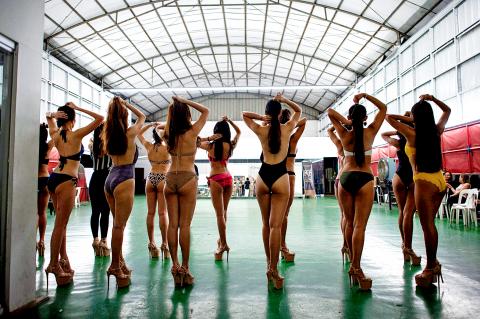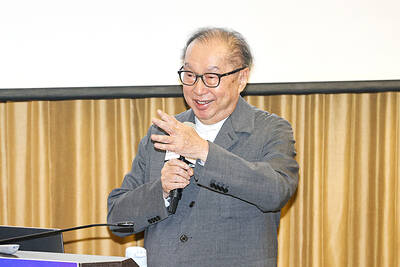Rodgil Flores cast a stern taskmaster’s glance as grimacing young women in bikinis strode across one of the mirror-walled studios that is central to making the Philippines a beauty pageant juggernaut.
In 17cm stiletto heels, the students swayed their hips between long slow strides, a brutal drill that Flores requires them to repeat in order to make the act of sashaying second nature come pageant time.
“For crown. For country,” is the slogan of the Kagandahang Flores studio he set up in 1996, the first of a handful of Philippine beauty boot camps that have helped transform the nation’s pageant fortunes.

Photo: AFP
With Catriona Gray last year winning Miss Universe, the Philippines took home its fourth title in what is considered the summit of the beauty contest world.
Gray and 2015 winner Pia Wurtzbach trained in the beauty studios before securing their wins.
Success in the pageant world can open doors to commercial, film and modeling work.
“The rise of the camps turned the Philippines into a beauty pageant powerhouse. What they did was to raise the level of pageant training,” Flores told reporters.
“Our evolution [into] a beauty pageant superpower compels every Filipina competing internationally to prolong this streak,” the 50-year-old added.
Manila’s beauty boot camps effectively create a production line of contenders for the Miss Universe crown. Their students come up from the country’s circuit of local beauty competitions and then hone their skills in a bid to reach the next level.
Miss Philippines hopeful Melba Ann Macasaet, 25, took extended leave from her job as a government pharmacist to join Flores’ beauty studio. It took her two weeks and several miscues to master his signature stride, called the “duck walk.”
“I have been joining pageants since I was 15 years old. I believe that every pageant girl has dreams of being able to try and do this,” she said.
It will be about another month before she knows if she has made the cut for the pageant, which organizers expect to be held in June.
The beauty boot camp runs six days a week and sessions often stretch on until midnight. About 200 hopefuls per year take part in the training at Flores’ studio, which include gym workouts, makeup lessons and duck walk drills.
There are also formal classes in which the students participate in mock pageant situations, learning to deliver concise responses to the tricky questions on world peace and equality usually asked of the contestants.
Training is free for Filipinas, who camp organizers usually recruit from provincial contests. Beauty industry benefactors pitch in to cover costs and many people donate their time to help shape what they hope are future champions.
“We don’t earn anything, but we do this out of our passion for beauty pageants,” said Arnold Mercado, the manager and personality development coach of Aces & Queens, the other main Philippine pageant camp.
Mercado, 51, quit his job as an engineer for an oil company after 28 years to focus full time on pageant coaching. He counts Wurtzbach and Gray among those he mentored.
“We’re so lucky here in the Philippines to be surrounded by teams of amazing people who will lift you up as you make all your preparations,” Gray told reporters on Wednesday last week.
Before the Manila boot camps arose, the country’s Miss Universe and Miss World contestants were sent to train at similar camps in Venezuela and Colombia, which have also had consistent pageant successes.
This was a significant expense in a nation where 21 percent of the population lives on less than US$2 per day and getting visas can be tricky.
The contests have a deeper cultural resonance for people in the Philippines, pageant resource Web site Missosology.org overall coordinator Ric Galvez said.
The events hark back to the annual pageants that have been held at village and town festivals for hundreds of years.
Beauty queens are held up as though they are royalty in the Philippines and often take public stances on key social and welfare issues.
During the Miss Universe pageant, Gray spoke in favor of medical marijuana, which some lawmakers feel has helped advance a bill to legalize cannabis-containing medicines in the Philippines.
“Filipinos are looking up to their beauty queens for some sort of guidance on matters of national relevance,” Galvez said.

BYPASSING CHINA TARIFFS: In the first five months of this year, Foxconn sent US$4.4bn of iPhones to the US from India, compared with US$3.7bn in the whole of last year Nearly all the iPhones exported by Foxconn Technology Group (富士康科技集團) from India went to the US between March and last month, customs data showed, far above last year’s average of 50 percent and a clear sign of Apple Inc’s efforts to bypass high US tariffs imposed on China. The numbers, being reported by Reuters for the first time, show that Apple has realigned its India exports to almost exclusively serve the US market, when previously the devices were more widely distributed to nations including the Netherlands and the Czech Republic. During March to last month, Foxconn, known as Hon Hai Precision Industry

Taiwan Semiconductor Manufacturing Co (TSMC, 台積電) and the University of Tokyo (UTokyo) yesterday announced the launch of the TSMC-UTokyo Lab to promote advanced semiconductor research, education and talent development. The lab is TSMC’s first laboratory collaboration with a university outside Taiwan, the company said in a statement. The lab would leverage “the extensive knowledge, experience, and creativity” of both institutions, the company said. It is located in the Asano Section of UTokyo’s Hongo, Tokyo, campus and would be managed by UTokyo faculty, guided by directors from UTokyo and TSMC, the company said. TSMC began working with UTokyo in 2019, resulting in 21 research projects,

Ashton Hall’s morning routine involves dunking his head in iced Saratoga Spring Water. For the company that sells the bottled water — Hall’s brand of choice for drinking, brushing his teeth and submerging himself — that is fantastic news. “We’re so thankful to this incredible fitness influencer called Ashton Hall,” Saratoga owner Primo Brands Corp’s CEO Robbert Rietbroek said on an earnings call after Hall’s morning routine video went viral. “He really helped put our brand on the map.” Primo Brands, which was not affiliated with Hall when he made his video, is among the increasing number of companies benefiting from influencer

Quanta Computer Inc (廣達) chairman Barry Lam (林百里) yesterday expressed a downbeat view about the prospects of humanoid robots, given high manufacturing costs and a lack of target customers. Despite rising demand and high expectations for humanoid robots, high research-and-development costs and uncertain profitability remain major concerns, Lam told reporters following the company’s annual shareholders’ meeting in Taoyuan. “Since it seems a bit unworthy to use such high-cost robots to do household chores, I believe robots designed for specific purposes would be more valuable and present a better business opportunity,” Lam said Instead of investing in humanoid robots, Quanta has opted to invest